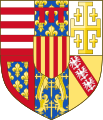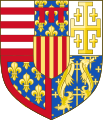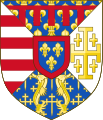René I. (Anjou)
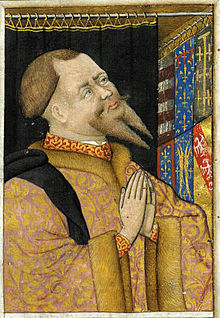

René I. d'Anjou or Renatus of Anjou (born January 16, 1409 in the castle of Angers ; † July 10, 1480 in Aix-en-Provence ), also René of Sicily, René of Naples, René the good or Le bon Roi René called, was Prince of the Holy Roman Empire and, among others:
- Count of Guise (1417–1425)
- Duke of Bar and Margrave of Pont-à-Mousson (1419 and 1430–1476)
- Duke of Lorraine (1431–1453, uxoris nomine )
- Duke of Anjou , Count of Provence , Forcalquier etc. (1434–1480)
- King of Naples etc. (1435–1442 actually, en titre until 1480) as well
- Titular King of Jerusalem (1435–1480) and
- Anti-King of Aragon (1466–1480).
Life
René of Anjou was the second son of Duke Ludwig II of Anjou and Jolanthe of Aragón . His maternal grandparents were King John I of Aragón and Violante von Bar . His sister was Maria von Anjou , who married the French King Charles VII in 1422 . Historian Desmond Seward describes him as "one of the most spectacular royal losers of the 15th century outside of England"
Guise
After the death of his father on April 29, 1417 he received the rule of Guise , which was raised to a county by his future brother-in-law, the Dauphin and later King Charles VII . Since the Dukes of Anjou were the Armagnacs and Bourguignons partisans of the Dauphins in the civil war , his property was confiscated by the Duke of Bedford , the English regent of France, when the English conquered northern France. Bedford awarded the county of Guise to John II of Luxembourg , Count of Ligny , who in 1425 conquered the castle of Guise .
bar
Cardinal Ludwig von Bar , the brother of René's grandmother Violante von Bar , set about actively managing the succession in the Duchy of Bar at the end of the 1410s when it was clear that - after his father, Duke Robert I , the descendants of his eldest son von had excluded the succession - after the death of his brother, Duke Edward III. in the battle of Azincourt and his own successor as a cleric in the Duchy of Bar no unproblematic successor would occur. In 1419 he brokered a marriage contract between René von Anjou, his great-nephew as the grandson of his sister Jolande von Bar, and Isabella (* probably 1400), the heir to Duke Charles II of Lorraine , who had the side effect of uniting Bar and Lorraine and the centuries-old differences between the duchies would end. On August 13, 1419, Ludwig renounced his duchy in favor of Renés in the Treaty of Saint-Mihiel . On October 24, 1420, René, now Duke of Bar , and Isabella married in Nancy Cathedral .
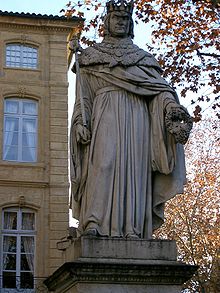
progeny
René and Isabella's children were:
- Isabella († young)
- John II (* 1425; † 1470), Duke of Lorraine, Duke of Calabria , Prince of Girona, 1458 governor of Genoa and for his father in the Kingdom of Naples
- René, (* probably 1426)
- Ludwig, (* 1427; † soon after 1444) Margrave of Pont-à-Mousson
- Nikolaus (* 1428; † small), Duke of Bar
- Jolande (* 1428; † 1483), Duchess of Lorraine etc .; ∞ Friedrich , Count of Vaudémont
- Margarete (* 1430; † 1482), ∞ Heinrich VI. , King of England
- Karl (* probably 1431; † 1432) Count of Guise
- Louise (* probably 1436; † small)
- Anne (* probably 1437; † small)
His second marriage to Jeanne de Laval in 1454 remained childless.
Lorraine (I)
With the death of Charles II of Lorraine on January 25, 1431, Isabella became Duchess of Lorraine, René Duke of Lorraine by virtue of his wife's rights. This succession plan had already been challenged by Count Anton von Vaudémont , Charles II's nephew and closest male relative, during Charles's lifetime, which is why Karl disinherited him in 1425. Charles' attacks on Antoine's property came to nothing, however, as Antoine had sought a powerful ally in Philip the Good , Duke of Burgundy . After the succession occurred, Antoine resumed the fight for the duchy, and on July 2, 1431 he succeeded in capturing René at the Battle of Bulgnéville .
On October 10, 1432, René and Antoine agreed to appeal to Philip the Good as arbitrator, but his mediation only brought about an agreement (Brussels, February 13, 1433), which included a marriage contract between children of the opposing parties, Jolande von Lorraine (* 1429) and Frederick II of Vaudémont (* 1417). René received temporary exemption until February 27, 1434, and the marriage contract was concluded on July 1, 1433. The wedding then took place when Jolande was 16 years old, around February 1445. In the previous year, René's heir Johann Marie de Bourbon, daughter of Duke Charles I and niece of Philip, married, which also contributed to the armistice between Burgundy and Lorraine.
Emperor Sigismund now invited René and Antoine to a court of arbitration in Basel (1434), on which he ruled in René's favor and enfeoffed him with Lorraine. Antoine then turned again to Philip the good, who in turn ordered René to go into captivity, which he then did. However, the conditions of detention were so bearable that René took part in the negotiations for the Treaty of Arras (1435) between Philip III. and Charles VII could participate. The Burgundian imprisonment was not lifted until 1437 due to a ransom payment, which René wanted to raise simply because his presence in southern Europe had become necessary in the meantime.
Anjou, Provence, Forqualquier
On November 12, 1434, his brother Ludwig III died. and left him the duchy of Anjou as well as the counties of Provence and Forcalquier - besides Bar the only inheritance that came to him without causing problems.
Naples (I)
Queen Johanna II of Naples had in 1423 Ludwig III. Adopted by Anjou and thus designated as his successor. After Ludwig's death, she transferred his claims (which also included the title of king of Jerusalem, Sicily, etc.) to the captive René, and died shortly afterwards, on February 2, 1435. Isabella set off in René's place, supported by Filippo Maria Visconti , Duke of Milan , and a Genoese fleet to take over the inheritance, whereby it was clear that they had to prevail against Alfonso V of Aragón , who also had claims due to an earlier adoption (which Johanna dissolved again) raised the crown of Naples. Alfons was defeated by the Genoese on August 5th, 1435 in the naval battle of Ponza, so that Isabella was able to move into Naples on October 18th. After paying the ransom, René himself was only able to come to Naples on May 19, 1438. Visconti's change of sides and growing military and political pressure from Aragon then led to René having to cede the kingdom to Alfonso V at the end of 1442. Other reasons were the fact that Alfons already had an excellent power base with Sicily, and René no longer had the financial means to assert himself after paying the ransom. René returned to France after his defeat, settled in Provence and handed over the administration of Lorraine to his eldest son Johann, whom he had made titular Duke of Calabria as the future heir of Naples .
Aragon (I)
On December 14, 1443 his mother, Yolande von Aragon, daughter of King John I , died, who left him her claims to Aragón. After Johann's death in 1396, the crown was passed on to his younger brother Martin I , then, through the compromise of Caspe in 1412, to his nephew, Ferdinand of Castile . Yolande had already claimed the throne without success. Here, too, Alfons V. Renés was the current adversary.
England and France
René and his brother Karl of Maine were the heads of the "Angevin Party" in the final phase of the Hundred Years War . In 1444 they signed an armistice with England, through which the family regained the Duchy of Maine, and through the marriage between René's daughter Margarete and the English King Henry VI. was consolidated in Nancy on April 23, 1445 - but this did not prevent René from standing on the side of Charles VII when the fighting flared up again, and him in the conquest of Normandy (entry into Rouen in November 1449) and in battle at Formigny (April 15, 1450).
Lorraine (II)
Isabella died on February 28, 1453 and René's son Johann became Duke of Lorraine. The following year, on November 10, 1454, René married Jeanne de Laval , daughter of Guy XIV , Count of Laval , and Isabelle de Bretagne for the second time . This marriage remained childless.
Naples (II)
On 26. June 1458 Alfonso V of Aragon died, after René its claims to Naples resumed - especially as the heir, Ferdinand or Ferrante led the stain of illegitimacy with him. He sent his son Johann to southern Italy, where he was also unsuccessful. After the defeat at Troia in Apulia in 1462, this chapter had to be finally closed.
Aragon (II)
When the cities of Catalonia rose up against Alfonso V's indirect successor, John II, in the 1460s and offered René the crown of Aragon, in 1466 he sent his son John to Barcelona, where he tried to assert his or René's claims without much success died four years later, whereupon René did not drop his claims, but Catalonia had to capitulate to John II in 1472.
Culture
In addition to his military activities, he devoted himself to the development of his holdings Anjou, Lorraine and Provence, especially the cities of Angers , Aix-en-Provence , Avignon and Tarascon . The Ponts-de-Cé castle and the Chanzé country house in Anjou go back to him.
In Aix and Angers he maintained literary and scientific circles; he devoted himself to the revival of ancient Provençal poetry by collecting the poetry of the troubadours and trying to write poetry himself: z. B. Traité de la forme et devis comme on fait les tournois (1451–1452) or Le Livre du cœur d'amour épris (1457, published 1825). He was the patron of the painter Nicolas Froment , ordered the work Le Mystère des Actes des Apôtres from Simon Gréban, a canon from Le Mans , and his brother Arnoul Gréban , a French writer.
He also tried himself as a painter, whereby many paintings in the style of old Dutch painting are attributed to him solely because they bear his coat of arms, but were actually only created on his behalf. He employed Barthélemy d'Eyck both as a court painter and as a valet. The most famous images associated with René are the “Burning Bush”, a triptych in the cathedral of Aix-en-Provence , which shows him with his second wife (actually a work by Nicolas Froment), an illuminated book of hours (today in the Bibliothèque nationale de France ), the illustrations in the Livre du cœur d'amour épris from around 1460 and the illustrations in the Traité de la forme et devis comme on fait les tournois from around 1462 - 1465 .
heritage
René I died in Aix on July 10, 1480. His remains were secretly stolen from Provence by the Angevins at night and finally buried in Angers Cathedral.
Provence, Forcalquier and Anjou fell as paternal inheritance to his nephew Charles of Maine , after his death in 1481 Anjou returned to the Domaine royal as a completed apanage , Provence and Forcalquier by will to King Louis XI. of France - who had already exerted pressure during René's lifetime to bring these areas into his possession. Lorraine had been in the possession of his daughter Yolande and her son René II , who was also the grandson of his former adversary Anton von Vaudémont, since 1473 . Cash was now added, as were the claims to Naples, Sicily and Jerusalem - the latter passed over this line to the House of Habsburg-Lothringen , which held the title until 1918.
Coat of arms gallery
See also
literature
- Marc-Édouard Gautier, François Avril (Ed.): Splendeur de l'enluminure. Le Roi René et les livres . Angers 2009.
- Wilhelm Wiegand : René d'Anjou . In: Allgemeine Deutsche Biographie (ADB). Volume 28, Duncker & Humblot, Leipzig 1889, pp. 207-209.
- Jules de Glouvet (di: Jules Quesnay de Beaurepaire): Histoires du Vieux Temps. Calmann Lévy, Paris 1889.
- Henry Bogdan: La Lorraine des Ducs. Sept siècles d'histoire. Perrin, Paris 2005, ISBN 2-262-02113-9 .
- Detlev Schwennicke : European family tables . New episode volume 2: The states outside Germany, the ruling houses of the other states of Europe. Stargardt, Marburg 1984, plate 26.
- Michael T. Reynolds: René of Anjou, King of Sicily, and the Order of the Croissant. In: Journal of Medieval History. Vol. 19, No. 1/2, 1993, pp. 125-161, doi: 10.1016 / 0304-4181 (93) 90011-Z .
Web links
Footnotes
- ^ "One of the most spectacular royal losers in fifteenth century Europe - outside of England." In: Desmond Seward: The Wars of the Roses. Through the Lives of five Men and Women of the Fifteenth Century. Penguin Books, New York NY 1995, ISBN 0-670-84258-3 , p. 51.
- ^ Marc-Édouard Gautier, François Avril 2009.
| predecessor | Office | successor |
|---|---|---|
| Ludwig II of Anjou |
Count of Guise 1417–1425 |
John II of Ligny |
| Ludwig |
Duke of Bar Margrave of Pont-à-Mousson 1419–1480 |
Jolande |
| Charles II |
Duke of Lorraine with Isabella 1431–1453 |
Johann II. |
| Ludwig III. from Anjou |
Duke of Anjou Count of Provence Count of Forcalquier Titular King Naples and Jerusalem 1434–1480 |
Charles IV (Charles V of Maine) |
| Joan II |
King of Naples 1435–1442 |
Alfonso V of Aragon |
| personal data | |
|---|---|
| SURNAME | René I. |
| ALTERNATIVE NAMES | Renatus; le bon Roi René; René of Anjou; René of Sicily; René of Naples; René the good |
| BRIEF DESCRIPTION | Duke of Anjou, Bar, Lorraine, Count of Provence, Titular King of Naples, Sicily, Jerusalem etc. |
| DATE OF BIRTH | January 16, 1409 |
| PLACE OF BIRTH | Angers Castle |
| DATE OF DEATH | July 10, 1480 |
| Place of death | Aix-en-Provence |





